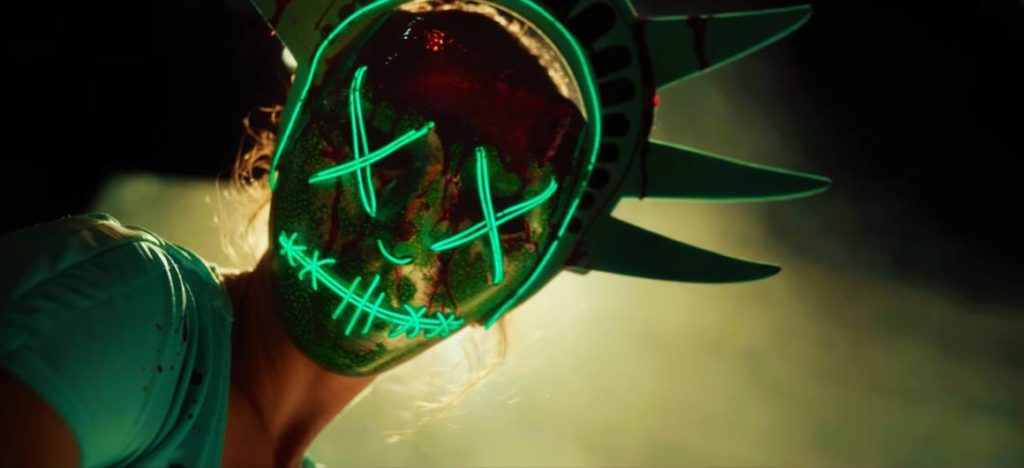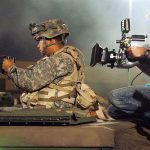Panic, Fear, and the “Election Year”
Although Michael Bay has producer credit on all three of the Purge franchise films, Election Year is the first one that shows it, and it’s easily the film’s greatest weakness.
Between the politicism of the movie and the big, shiny explosions, the former is the more interesting element by far. Make no mistake—The Purge: Election Year is a political film, and not a subtle one.
Trigger warning: discussion of gun violence and oppression, images depicting violence.
That said, the most specific, topical message that the film carries is blink-and-you’ll-miss-it quick: in a presidential debate early on in the film, Senator Charlie Roan (Elizabeth Mitchell) suggests that the Purge sacrifices the safety of our most vulnerable citizens in order to line the pockets of the NRA. While the majority of the movie attributes the gun-toting madness to the fictional government organization entitled “The New Founding Fathers of America,” or NFFA, it makes a point to draw an explicit parallel from the very beginning.
As we set out to see the film, my friend said that she always got a bit nervous going to the movie theater. Shooters have targeted movie theaters in Colorado, Louisiana, Tennessee, and Florida, all within the last four years. It’s not just movie theaters, obviously; a mass shooting happens in the United States every two months or so, and the deadliest in recent history targeted the queer community in Orlando. Although the movie doesn’t discuss the particular struggles of gender and sexuality minorities, that sense of collective fear in the face of an epidemic of gun violence is an important part of the culture that created this movie.
 The idea of Purge Night—the one night a year when all crime is legal—holds a great deal of potential, but the franchise’s first film lacked luster because its main characters didn’t have strong stances on the wider implications of a world where Purge Night actually exists. Purge: Anarchy honed its criticism of any governmental system that sacrifices the welfare of its citizens for financial gain, especially through the marginalization (in this case, literal elimination) of lower-class people, people of color, and people with special needs who rely on government assistance to survive. While Leo Barnes (Frank Grillo) contemplated the advantages of Purge Night (sweet revenge!), the other citizens with whom he joins forces understand that the Purge victimizes the poor, who cannot afford to protect themselves with elaborate security systems. A resistance movement begins, culminating in the third film.
The idea of Purge Night—the one night a year when all crime is legal—holds a great deal of potential, but the franchise’s first film lacked luster because its main characters didn’t have strong stances on the wider implications of a world where Purge Night actually exists. Purge: Anarchy honed its criticism of any governmental system that sacrifices the welfare of its citizens for financial gain, especially through the marginalization (in this case, literal elimination) of lower-class people, people of color, and people with special needs who rely on government assistance to survive. While Leo Barnes (Frank Grillo) contemplated the advantages of Purge Night (sweet revenge!), the other citizens with whom he joins forces understand that the Purge victimizes the poor, who cannot afford to protect themselves with elaborate security systems. A resistance movement begins, culminating in the third film.
Thus, Election Year folds Purge politics into the media circus that is a presidential race in America. With this installment, Leo serves as Senator Roan’s chief security guard, tasked with protecting her during an unusually dangerous Purge Night: the first one to allow the murder of high-ranking political leaders as well as ordinary citizens. For help, they turn to denizens Joe Dixon (Mykelti Williamson), Marcos (Joseph Julian Soria), and the film’s most interesting character, Laney “Pequeña Muerte” Rucker (Betty Gabriel)—who deserved far more screentime for her backstory, by the way.
Despite its real-world applicability, the third Purge film uses plenty of goosebump-inducing, horror-movie imagery, from a back-alley guillotine to a bloody midnight mass (embedded in a criticism of the Church’s failure to commit to a fully pacifist ideology, of course). The most iconic image is probably the neon-skull Statue of Liberty costume that graced many of the film’s promotional posters. It also features a teenaged girl gang, a pig mascot costume with a pacifier, and a giddy group of murder tourists prancing through the blood-soaked streets.
 At times, Election Year errs on the side of over-the-top, resulting in fiery explosions and high-tech gadgets that rob the film of some of the grit that made Anarchy so much more interesting to watch. But The Purge has earned at least some of that sensationalism; this film is the culmination of the franchise—at least for now—and deserves to take its critiques to their most visually arresting conclusions. The cinematic hyperbole is worth it when you spy some of the little details, like Confederate flags sewn into the uniforms of some of the pro-Purge military men.
At times, Election Year errs on the side of over-the-top, resulting in fiery explosions and high-tech gadgets that rob the film of some of the grit that made Anarchy so much more interesting to watch. But The Purge has earned at least some of that sensationalism; this film is the culmination of the franchise—at least for now—and deserves to take its critiques to their most visually arresting conclusions. The cinematic hyperbole is worth it when you spy some of the little details, like Confederate flags sewn into the uniforms of some of the pro-Purge military men.
All in all, Purge: Election Year is a balancing act between two functions: one, a criticism of systemic yet oft-denied racism, classism, sexism, and other mechanisms of oppression that claim the lives of innocent citizens, and two, the shiny action movie tropes more closely associated with box office dollars. At times, that balance tilts too far toward the latter, to the detriment of the film’s success at the former. Still, the overall experience is engaging enough to please fans of horror and action, if not fans of more realistic political pictures. (It’s also perfect for the fandom set’s penchant for “sarcastic patriotism.” Happy birthday, America, the greatest country in the world! Purge and purify!)
And if the mantra “God bless America, a nation reborn” calls to mind a certain presumptive candidate’s presidential campaign, well—this movie wasn’t designed for subtlety.
Author: Kate Colvin
Help support independent journalism. Subscribe to our Patreon.
Copyright © The Geekiary
Do not copy our content in whole to other websites. If you are reading this anywhere besides TheGeekiary.com, it has been stolen.Read our







